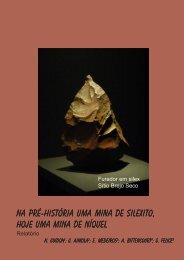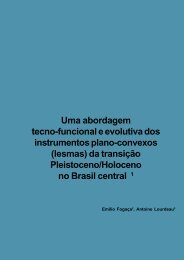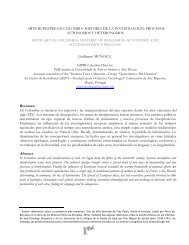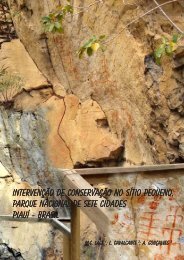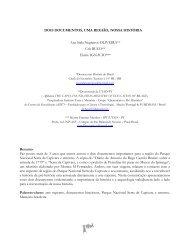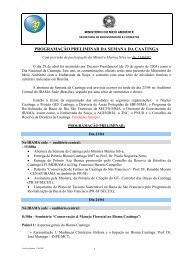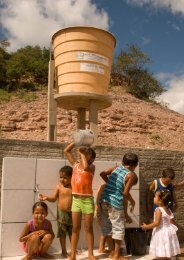O Homem seguiu as plantas ou as plantas seguiram o Homem?
O Homem seguiu as plantas ou as plantas seguiram o Homem?
O Homem seguiu as plantas ou as plantas seguiram o Homem?
- No tags were found...
Create successful ePaper yourself
Turn your PDF publications into a flip-book with our unique Google optimized e-Paper software.
O <strong>Homem</strong> <strong>seguiu</strong> <strong>as</strong> plant<strong>as</strong> <strong>ou</strong> <strong>as</strong><br />
plant<strong>as</strong> <strong>seguiram</strong> o <strong>Homem</strong><br />
Rot<strong>as</strong> migratóri<strong>as</strong> e de contato do<br />
<strong>Homem</strong> pré-histórico<br />
n<strong>as</strong> Améric<strong>as</strong> segundo <strong>as</strong> plant<strong>as</strong><br />
cultivad<strong>as</strong>.<br />
Estudo de c<strong>as</strong>o - milho<br />
Freit<strong>as</strong>, F.O 1 Bustamante, P.G 2 , Ferreira,<br />
P.C.G 3<br />
FUMDHAMentos VII - Fábio Freit<strong>as</strong> et alii 102
Resumo<br />
O alimento é um dos fatores que determinaram à permanência <strong>ou</strong> migração do homem pré-histórico<br />
de uma dada região. Ao longo da história humana, <strong>as</strong> sociedades alteraram geneticamente <strong>as</strong> plant<strong>as</strong>,<br />
domesticando-<strong>as</strong>. Esse fato torn<strong>ou</strong> o homem mais independente do meio e culturalmente mais<br />
relacionado/dependente da planta cultivada. O milho é uma d<strong>as</strong> principais espécies domesticad<strong>as</strong> no<br />
mundo, possuindo milhares de etnovariedades, moldad<strong>as</strong> pelo ambiente e pela cultura humana. A<br />
partir de análises genétic<strong>as</strong> de amostr<strong>as</strong> de milho arqueológico e indígena, podem-se verificar pelo<br />
menos du<strong>as</strong> grandes lev<strong>as</strong> introdutóri<strong>as</strong> de raç<strong>as</strong> distint<strong>as</strong> de milho, a partir do México. A primeira por<br />
volta de 5.000 anos atrás e difundida através dos Andes. A segunda, há 2.000 anos atrás, difundida<br />
pela região d<strong>as</strong> terr<strong>as</strong> baix<strong>as</strong> da América do Sul. Estes dois padrões refletem um isolamento cultural<br />
entre ess<strong>as</strong> regiões. Em termos alimentares, <strong>as</strong> populações habitantes do Br<strong>as</strong>il, incluindo a Amazônica,<br />
possuíam uma maior relação com a América Central e norte da América do Sul, do que com a região<br />
Andina. Exceção é a região do norte do Chile até Paraguai/Paraná onde a mistura destes padrões<br />
genéticos indica possíveis contatos culturais entre <strong>as</strong> populações daquel<strong>as</strong> regiões.<br />
FUMDHAMentos VII - Fábio Freit<strong>as</strong> et alii 103
Introdução<br />
A colonização d<strong>as</strong> Améric<strong>as</strong> pelo homem pré-histórico é ainda motivo de controvérsi<strong>as</strong>, principalmente<br />
em relação à data de chegada dos primeiros homens vindos da Ásia (Neves et al, 1989; Pena et al,<br />
1989; Pr<strong>ou</strong>s, 1989; Roosevelt, 1996). Independentemente de quando o homem cheg<strong>ou</strong> n<strong>as</strong> Améric<strong>as</strong>,<br />
após seu primeiro p<strong>as</strong>so em solo do continente Americano, ele p<strong>as</strong>s<strong>ou</strong> a migrar e colonizar regiões,<br />
desde o extremo Norte até o Sul do continente. Populações, tradições e etni<strong>as</strong> floresceram e começaram<br />
a ser difundid<strong>as</strong> através do tempo e espaço. Tentar traçar est<strong>as</strong> migrações “intern<strong>as</strong>” depende tanto<br />
de evidênci<strong>as</strong> atuais, a partir d<strong>as</strong> populações remanescentes dos primeiros habitantes; quanto de<br />
dados históricos gerados nos últimos 500 anos; além de evidênci<strong>as</strong> arqueológic<strong>as</strong> (Harlan, 1975).<br />
Após certo período do estabelecimento do homem n<strong>as</strong> Améric<strong>as</strong>, uma série de espécies p<strong>as</strong>saram<br />
a ser domesticad<strong>as</strong> <strong>ou</strong> semi-domesticad<strong>as</strong>, há mais <strong>ou</strong> menos 8.000 anos atrás, muit<strong>as</strong> d<strong>as</strong> quais<br />
são <strong>as</strong> b<strong>as</strong>es d<strong>as</strong> principais cultur<strong>as</strong> de que nos alimentamos atualmente. Futur<strong>as</strong> espécies<br />
domesticad<strong>as</strong> como o milho, tomate, feijão, amendoim, mandioca, entre tant<strong>as</strong> <strong>ou</strong>tr<strong>as</strong>, começavam<br />
a ser criad<strong>as</strong>, domesticad<strong>as</strong> a partir de seus ancestrais selvagens, pela influência humana (Harlan,<br />
1971; 1975; Gepts & Deb<strong>ou</strong>ck, 1991).<br />
Est<strong>as</strong> plant<strong>as</strong> domesticad<strong>as</strong> foram disseminad<strong>as</strong> pelo homem a partir do seu respectivo local de origem<br />
e, quando da chegada dos europeus no século XV, <strong>as</strong> principais espécies domesticad<strong>as</strong> do Novo<br />
Mundo já estavam amplamente disseminad<strong>as</strong> pelo continente americano. É o c<strong>as</strong>o, por exemplo, do<br />
milho, que o colonizador encontr<strong>ou</strong> sendo plantado em tod<strong>as</strong> <strong>as</strong> três Améric<strong>as</strong>, atingindo latitudes<br />
elevad<strong>as</strong> nos dois hemisférios e sendo encontrad<strong>as</strong> desde o nível do mar até alt<strong>as</strong> altitudes, reflexo de<br />
sua diversidade genética, para poder ocupar uma gama de ambientes tão distintos.<br />
Toda essa diversidade se explica, em parte, pela importância que esta planta teve e ainda tem como<br />
b<strong>as</strong>e alimentar da maioria d<strong>as</strong> populações d<strong>as</strong> Améric<strong>as</strong>. Tratado por muit<strong>as</strong> cultur<strong>as</strong> como algo<br />
sagrado, o milho, ao longo de sua trajetória evolutiva e de disseminação, foi sendo selecionado tanto<br />
pelos fatores ambientais característicos de cada local onde era plantado, quanto também foi selecionado<br />
pelo próprio homem, segundo <strong>as</strong> tradições culturais e gostos de cada população humana e os usos<br />
que dele eram feitos, desde preparos de comid<strong>as</strong>, bebid<strong>as</strong> e até ornamentais.<br />
Est<strong>as</strong> seleções naturais e artificiais (pelo homem) d<strong>as</strong> plant<strong>as</strong> cultivad<strong>as</strong>, geraram uma série de<br />
variedades/ raç<strong>as</strong> locais, muit<strong>as</strong> vezes ligad<strong>as</strong> diretamente a grupos humanos específicos.<br />
Deste modo, ao analisarmos diferentes raç<strong>as</strong> locais de uma dada espécie cultivada, pode-se tentar<br />
traçar uma relação entre est<strong>as</strong> diferentes variedades locais, verificando quais aquel<strong>as</strong> que possuem<br />
maior afinidade e quais <strong>as</strong> mais distantes. Ao adicionarmos o dado geográfico, pode-se analisar uma<br />
relação espacial entre <strong>as</strong> amostr<strong>as</strong>. Ainda, ao incluirmos na análise dados de amostr<strong>as</strong> arqueológic<strong>as</strong>,<br />
pode-se adicionar a dimensão temporal, indicando qual a característica de dada amostra, onde ela se<br />
localizava e em qual momento histórico isto se deu (Freit<strong>as</strong>, et al, 2003).<br />
FUMDHAMentos VII - Fábio Freit<strong>as</strong> et alii 104
Objetivo<br />
Neste trabalho, iremos apresentar possíveis rot<strong>as</strong> de difusão do milho, em tempos remotos e, em<br />
paralelo, <strong>as</strong> possíveis rot<strong>as</strong> de migração e contatos culturais d<strong>as</strong> populações human<strong>as</strong> do p<strong>as</strong>sado.<br />
Materiais e Método<br />
Neste trabalho analis<strong>ou</strong>-se diretamente 45 amostr<strong>as</strong> tradicionais e indígen<strong>as</strong> de milho de diferentes<br />
locais do Br<strong>as</strong>il e Paraguai; além de sete amostr<strong>as</strong> arqueológic<strong>as</strong> de milho, provenientes de cavern<strong>as</strong><br />
localizad<strong>as</strong> no Vale do Peruaçu – MG – Br<strong>as</strong>il, com idade que variaram entre 1.100 e 560 A.P.<br />
Foram incluíd<strong>as</strong> na análise dados de literatura, com amostr<strong>as</strong> da região de origem do milho, no México<br />
e Guatemala e amostr<strong>as</strong> ao longo da cordilheira dos Andes, sendo 3 del<strong>as</strong> arqueológic<strong>as</strong> (idade que<br />
variaram entre 4.500 e 400 anos A.P.). (Gol<strong>ou</strong>binoff et al, 1993).<br />
De cada uma d<strong>as</strong> amostr<strong>as</strong> foi extraído fragmentos de material genético (DNA). A metodologia<br />
utilizada foi a técnica de extração por CTAB, com uma purificação secundária, como reportado em<br />
Allaby et al (1997), onde a seqüência alvo analisada pertence ao gene Adh2 (Freit<strong>as</strong>, et al, 2003;<br />
Bustamante, 2005).<br />
Os fragmentos de DNA obtidos foram então seqüenciados e comparados por Network, que permite<br />
identificar <strong>as</strong> mutações ocorrid<strong>as</strong> em cada uma d<strong>as</strong> seqüênci<strong>as</strong>, ao longo da evolução do milho (Allabi<br />
& Brown, 2000; Freit<strong>as</strong>, 2001; Bustamante, 2005).<br />
Resultados e discussão<br />
Primeiramente, a análise mostr<strong>ou</strong> que o milho apresenta uma alta diversidade genética na região<br />
(gene) estudada, apresentando diversões tipos/ padrões genético, dependendo da amostra estudada,<br />
o que permite um estudo mais aprofundado.<br />
De modo geral, verific<strong>ou</strong>-se que tod<strong>as</strong> <strong>as</strong> seqüênci<strong>as</strong> d<strong>as</strong> amostr<strong>as</strong> variaram dentro de três padrões/<br />
grupos genéticos principais, sendo um tipo chamado de “simples”, mais antigo e, <strong>ou</strong>tros dois<br />
identificados como complexos, mais recentes. Nomes estes devido <strong>as</strong> particularidades genétic<strong>as</strong> da<br />
seqüência de cada um destes padrões.<br />
O interessante é que estes padrões apresentaram uma distribuição geográfica específica (Figura 1),<br />
onde um dos padrões, o mais primitivo (amostr<strong>as</strong> da cor branca, na figura), fic<strong>ou</strong> restrito b<strong>as</strong>icamente<br />
a região d<strong>as</strong> terr<strong>as</strong> alt<strong>as</strong>, ao longo da Cordilheira dos Andes; enquanto os <strong>ou</strong>tros dois padrões (azul e<br />
vermelho, na figura) predominaram na região d<strong>as</strong> terr<strong>as</strong> baix<strong>as</strong> (Figura 1).<br />
Isto sugere a entrada de tipos distintos de milho na América do Sul, a partir da América Central e, mais,<br />
por rot<strong>as</strong> de difusão diferentes.<br />
FUMDHAMentos VII - Fábio Freit<strong>as</strong> et alii 105
O primeiro tipo de milho a entrar na América do Sul foi o tipo simples, fato este indicado pel<strong>as</strong> amostr<strong>as</strong><br />
arqueológic<strong>as</strong> do estudo, onde este padrão genético simples está presente de forma exclusiva n<strong>as</strong><br />
amostr<strong>as</strong> encontrad<strong>as</strong> no Peru, com idades de 4.500 A.P. (Gol<strong>ou</strong>binoff et al, 1993). Aparentemente<br />
este tipo simples foi difundido na região ao longo da Cordilheira dos Andes.<br />
Posteriormente, novos tipos distintos de milho foram disseminados/ difundidos na América do Sul,<br />
entretanto, naquele momento, por novos caminhos, se espalhando pela região d<strong>as</strong> terr<strong>as</strong> baix<strong>as</strong><br />
do continente sul americano. Est<strong>as</strong> conclusões ficam mais evidentes quando observamos a figura<br />
2, onde são apresentad<strong>as</strong> apen<strong>as</strong> <strong>as</strong> amostr<strong>as</strong> coletad<strong>as</strong> junto a populações indígen<strong>as</strong> e a partir<br />
de amostr<strong>as</strong> arqueológic<strong>as</strong>.<br />
O interessante é notar que, aparentemente, estes padrões “terra alta” – “terra baixa” não se misturaram,<br />
ficando, de modo geral, confinados em su<strong>as</strong> regiões originais de difusão, como pode-se observar ao<br />
se comparar <strong>as</strong> figur<strong>as</strong> 1 e 2.<br />
Este isolamento de tipos, mais do que devido a restrições impost<strong>as</strong> pela genética do material é,<br />
principalmente, devido a isolamentos culturais, <strong>ou</strong> seja, imposta mais pelos isolamentos em termos de<br />
relacionamentos (amistosos <strong>ou</strong> não) que <strong>as</strong> populações human<strong>as</strong> do p<strong>as</strong>sado mantinham.<br />
Outr<strong>as</strong> considerações particulares que podemos observar a partir d<strong>as</strong> amostr<strong>as</strong> são:<br />
1. A região sul do continente, entre a parte norte do Chile e Argentina, até o Paraguai, mostra<br />
que é uma região onde o contato leste – oeste foi efetivo, onde pode-se encontrar amostr<strong>as</strong> com<br />
padrões d<strong>as</strong> terr<strong>as</strong> alt<strong>as</strong> n<strong>as</strong> terr<strong>as</strong> baix<strong>as</strong> (amostra E11) e vice versa (G7). Faz-se interessante<br />
notar que esta região se localiza onde os estudiosos indicam ser o famoso caminho Peabiru, que<br />
ligava <strong>as</strong> du<strong>as</strong> cost<strong>as</strong> do continente sul-americano, mostrando como estes tipos de dados podem<br />
corroborar <strong>ou</strong>tr<strong>as</strong> evidênci<strong>as</strong>;<br />
2. A região amazônica possui b<strong>as</strong>icamente os tipos complexos, de terra baixa. Isto se faz<br />
importante, principalmente quando existem correntes de estudo divergentes a respeito da influência<br />
que tiveram <strong>as</strong> populações human<strong>as</strong> da região amazônica, com grupos afirmando que a região<br />
sofreu influência andina, enquanto <strong>ou</strong>tra corrente sugere o contrário. Pelo trabalho e, particularmente<br />
em termos alimentar e, mais especificamente no c<strong>as</strong>o do milho, <strong>as</strong> populações habitantes da<br />
região amazônica, praticamente não tiveram influência andina;<br />
3. A presença de uma única amostra do tipo terra alta, no estado do Acre, na região Amazônica<br />
(7), pode indicar uma pequena influencia andina. Entretanto, esta influencia pode ter sido já em tempos<br />
mais recentes, principalmente ao lembrarmos que a região do Acre, no final do século XIX e início do<br />
século XX, p<strong>as</strong>s<strong>ou</strong> pelo chamado ciclo da borracha, com o aporte de muitos migrantes não-indios<br />
para aquela região, o que acab<strong>ou</strong> por deslocar muit<strong>as</strong> populações indígen<strong>as</strong> de su<strong>as</strong> terr<strong>as</strong> originais,<br />
indo se abrigar mais ao sopé dos Andes, no Peru e, com isto, acarretando um contato com <strong>ou</strong>tr<strong>as</strong><br />
populações indígen<strong>as</strong> com maior influencia da cultura d<strong>as</strong> terr<strong>as</strong> alt<strong>as</strong>. Com o fim do ciclo da borracha,<br />
muit<strong>as</strong> populações indígen<strong>as</strong> retornaram para sua terra natal, sendo que algum<strong>as</strong> del<strong>as</strong> podem ter<br />
trazido matéri<strong>as</strong> agrícol<strong>as</strong> recém adquiridos, incluindo o milho.<br />
4. A região observada com maior diversidade de padrões e sub-padrões genéticos é a região<br />
ao norte da região amazônica, no estado de Roraima, n<strong>as</strong> proximidades da parte sul da Venezuela<br />
(amostr<strong>as</strong> 8; 9; 10; 24; 25; 26; 27 e; 28), tendo sido encontrado 9 haplotipos dos 13 encontrados<br />
no estudo e literatura. Isto indica que a região pode ter sido uma importante rota de contatos entre<br />
FUMDHAMentos VII - Fábio Freit<strong>as</strong> et alii 106
distint<strong>as</strong> populações. Possíveis motivos: geográfico – bem ao norte do continente, próximo a porta de<br />
entrada do milho a partir do centro de origem, no México; Rios que servem como rot<strong>as</strong> naturais de<br />
difusão de populações human<strong>as</strong> e su<strong>as</strong> cultur<strong>as</strong> e cultivos; único local com presença de um tipo de<br />
padrão genético hibrido, mostrando a antiguidade do milho ali. Estado com colonização não-índia<br />
mais recente, com grande % da população ainda indígena, e grandes extensões de reserv<strong>as</strong> indígen<strong>as</strong>,<br />
fazendo com que o impacto da sociedade nest<strong>as</strong> populações tradicionais tenha sido amenizado e<br />
mais recente, permitindo a sobrevivência não apen<strong>as</strong> d<strong>as</strong> cultur<strong>as</strong>/ etni<strong>as</strong>, como de seus cultivos.<br />
Considerações finais<br />
Neste trabalho analis<strong>ou</strong>-se dados oriundos de amostr<strong>as</strong> de milho, uma importante planta alimentar<br />
para <strong>as</strong> sociedades human<strong>as</strong> atuais e essencial para muit<strong>as</strong> populações indígen<strong>as</strong> do presente e<br />
do p<strong>as</strong>sado mais remoto.<br />
Verific<strong>ou</strong>-se que esta planta possui característic<strong>as</strong> genétic<strong>as</strong> que estão distribuíd<strong>as</strong> geograficamente, desde<br />
tempos mais remotos, como mostrado pel<strong>as</strong> amostr<strong>as</strong> arqueológic<strong>as</strong> e que são explicad<strong>as</strong>, principalmente,<br />
pelo fator homem, <strong>ou</strong> seja, devido à influência e ação de difusão que este exerceu sobre aquela planta, a<br />
partir do centro de origem da espécie cultivada, no México/ Guatemala.<br />
Como o padrão genético-geográfico apresentado pelo milho é explicado pela ação do homem, a planta<br />
serve, por <strong>ou</strong>tro lado, como um marcador/ indicador por onde o homem p<strong>as</strong>s<strong>ou</strong> e/<strong>ou</strong> quais eram <strong>as</strong> rot<strong>as</strong><br />
preferenciais de contato/ migração d<strong>as</strong> diferentes cultur<strong>as</strong> human<strong>as</strong> que habitaram a América do Sul.<br />
Deste modo, os dados apresentados reforçam a teoria de du<strong>as</strong> grandes cultur<strong>as</strong> human<strong>as</strong>, uma de<br />
terr<strong>as</strong> alt<strong>as</strong> e a <strong>ou</strong>tra para <strong>as</strong> terr<strong>as</strong> baix<strong>as</strong>. Aparentemente, em termos alimentar, est<strong>as</strong> du<strong>as</strong> cultur<strong>as</strong><br />
ficaram relativamente isolad<strong>as</strong> uma da <strong>ou</strong>tra, com exceção de algum<strong>as</strong> regiões onde o contato pode<br />
ter ocorrido de forma mais efetiva, como explicitado no artigo.<br />
Em termos de região amazônica, a qual possui controvérsia sobre sua influência cultural, podemos<br />
afirmar que, em termos alimentar e, mais especificamente o milho, que a cultura humana que habit<strong>ou</strong> a<br />
região Amazônica no p<strong>as</strong>sado sofreu uma influencia muito maior de cultur<strong>as</strong> human<strong>as</strong> d<strong>as</strong> terr<strong>as</strong> baix<strong>as</strong><br />
e muito p<strong>ou</strong>co da região Andina.<br />
Por último, o trabalho reforça a importância dos estudos que focam <strong>as</strong> plant<strong>as</strong> utilizad<strong>as</strong> pelo homem,<br />
nos estudos sobre a história do p<strong>as</strong>sado do próprio homem, sugerindo que trabalhos de prospecção<br />
arqueologia devam dar maior cuidado com <strong>as</strong> amostr<strong>as</strong> vegetais encontrad<strong>as</strong> nos sítios, pois est<strong>as</strong><br />
podem servir como complemento aos dados de <strong>ou</strong>tr<strong>as</strong> fontes de estudo.<br />
Agradecimentos<br />
Agradecemos ao Dr. André Pr<strong>ou</strong>s e sua equipe, pel<strong>as</strong> amostr<strong>as</strong> arqueológic<strong>as</strong> emprestad<strong>as</strong> para<br />
o estudo; à Embrapa por ter fornecido <strong>as</strong> amostr<strong>as</strong> de milho de sua coleção; aos índios de ontem<br />
e de hoje, que geraram est<strong>as</strong> variedades de plant<strong>as</strong>. Ao Programa Biodiversidade Br<strong>as</strong>il-Itália,<br />
pelo apoio financeiro.<br />
FUMDHAMentos VII - Fábio Freit<strong>as</strong> et alii 107
Have people followed plants or have plants followed people Pre-historical human migratory<br />
and contact r<strong>ou</strong>tes in the Americ<strong>as</strong> according to crops. C<strong>as</strong>e study – Maize<br />
ABSTRACT<br />
Food is one of the key factors that h<strong>as</strong> determined pre-historical human settlement or migration in<br />
an area. Thr<strong>ou</strong>gh<strong>ou</strong>t human history, societies have changed plants genetically, thr<strong>ou</strong>gh domestication.<br />
This fact made the human beings more independent of the environment and culturally more related<br />
to/dependent on crops. Maize is one of the most important crop species in the world, with th<strong>ou</strong>sands<br />
of landraces, selected by the environment and by human culture. Genetic analyses with archeological<br />
and indigen<strong>ou</strong>s maize samples show at le<strong>as</strong>t two main ancient expansions of maize cultivation into<br />
S<strong>ou</strong>th America from Mexico. The first one happened ar<strong>ou</strong>nd 5,000 years ago, and w<strong>as</strong> diffused<br />
thr<strong>ou</strong>gh<strong>ou</strong>t the Andean Highlands. The second one, which happened ar<strong>ou</strong>nd 2,000 years ago, w<strong>as</strong><br />
diffused thr<strong>ou</strong>gh<strong>ou</strong>t the S<strong>ou</strong>th American Lowlands. The two patterns reflect cultural isolations between<br />
these two are<strong>as</strong>. In regard to food, Brazilian human populations, including the Amazonian had a<br />
closer relation to the Central American and the Northern part of S<strong>ou</strong>th American, rather than the<br />
Andean Highlands. An exception is the area from the Northern part of Chile up to Paraguay/ Parana-<br />
Brazil, where there is a mixture of these two genetic patterns, indicating some possible cultural<br />
contacts between the human populations of the two are<strong>as</strong>.<br />
FUMDHAMentos VII - Fábio Freit<strong>as</strong> et alii 108
DID MAN FOLLOW PLANTS OR DID PLANTS FOLLOW MAN TRACKS OF<br />
PREHISTORIC MAN AND WAYS OF CONTACT IN THE AMERICAS,<br />
ACCORDING TO CULTIVATED PLANTS. CASE-STUDY – MAIZE<br />
Introduction<br />
The colonization of the Americ<strong>as</strong> by prehistoric man still provokes controversy, above all the date of<br />
man’s first arrival from Asia (Neves et al, 1989;Pena et al, 1989; Pr<strong>ou</strong>s, 19889; Roosevelt, 1996).<br />
Independent from when this happened, <strong>as</strong> soon <strong>as</strong> man stepped on American soil, he began to migrate<br />
and colonize the c<strong>ou</strong>ntry, from the extreme north to the s<strong>ou</strong>th of the continent. Populations, traditions and<br />
ethnic gr<strong>ou</strong>ps fl<strong>ou</strong>rished and started to spread over time and space. To track down these “internal”<br />
migrations, depends on actual evidence, starting with surviving populations from the first inhabitants, <strong>as</strong><br />
well <strong>as</strong> on historical data from the l<strong>as</strong>t 500 years and on archaeological evidence (Harlan, 1975).<br />
Approx. 8.000 years ago, after an initial period of settling down some species were domesticated<br />
or semi-domesticated by man, and many of them constitute the b<strong>as</strong>is of the crops which feed us<br />
today. Prospective species like maize, tomatoes, beans, peanuts and manioc, among others began<br />
to be grown, were domesticated from their wild ancestors by man. (Harlan, 1971; 1975; Gepts &<br />
Deb<strong>ou</strong>ck, 1991).<br />
These domesticated plants were distributed by man from where he started <strong>ou</strong>t and when Europeans<br />
arrived in the 15 th century, the principal domesticated species of the new world had already begun to<br />
spread over the American continent. This is the c<strong>as</strong>e of maize, which the colonizers discovered <strong>as</strong><br />
being grown in the three Americ<strong>as</strong>, in the high latitudes of the two hemispheres <strong>as</strong> well <strong>as</strong> on sea level or<br />
up in high altitudes, reflecting its genetic diversity to cover such a large range of different environments.<br />
This diversity may partly be explained by the value this plant had and still h<strong>as</strong> <strong>as</strong> the staple food for the<br />
majority of the American populations. Maize w<strong>as</strong> regarded by many cultures <strong>as</strong> something sacred and<br />
during its c<strong>ou</strong>rse of evolution and dissemination w<strong>as</strong> selected because of the characteristic environmental<br />
factors where it w<strong>ou</strong>ld grow and by proper man according to his cultural traditions, his t<strong>as</strong>tes and uses,<br />
ranging from the preparation of food and drink to decoration.<br />
These natural and artificial selections of cultivated plants caused a series of variations/local breeds<br />
often correlated directly to specific human gr<strong>ou</strong>ps.<br />
Thus, analyzing different local variations of a given cultivated species, a connection between these might<br />
be claimed, determining those variations with a major or minor affinity. When geographical specifications<br />
are added, a topographical relationship between samples can be established. Furthermore, including<br />
archaeological data, a time dimension is added, pointing <strong>ou</strong>t what characterizes the given sample,<br />
where it is located and when this happened (Freit<strong>as</strong> et al, 2003).<br />
FUMDHAMentos VII - Fábio Freit<strong>as</strong> et alii 109
Objective<br />
We are going to present possible roads of diffusion for maize, in ancient times, and, parallel to that,<br />
possible ways of migration and contact of peoples in the p<strong>as</strong>t.<br />
Materials and Methods<br />
For this paper we analyzed directly 45 specimens of traditional and indigen<strong>ou</strong>s maize from different<br />
locations in Brazil and Paraguay, also 7 archaeological samples from caverns situated in the Peruaçu<br />
valley – Min<strong>as</strong> Gerais – Brazil, with ages varying between 1.100 and 560 year BP.<br />
We included data from literature, with samples from the area where maize originated, in Mexico and<br />
Guatemala and specimens from the Cordiller<strong>as</strong>, three of which were archaeological (with ages varying<br />
between 4.500 and 400 years BP). (Gol<strong>ou</strong>binoff et al, 1993)<br />
From each sample a segment of genetic material (DNA) w<strong>as</strong> extracted. The method applied w<strong>as</strong> the<br />
genomic extraction using CTAB, with a secondary purification <strong>as</strong> reported by Allaby et al (1997), where<br />
the analyzed target sequence belongs to gene Adh2 (Freit<strong>as</strong> et al, 2003, Bustamante, 2005).<br />
The DNA segments thus obtained were then sequenced and compared by Network permitting to<br />
identify the mutations which took place in each sequence during the evolution of maize (Allaby &<br />
Brown, 2000; Freit<strong>as</strong>, 2001; Bustamante, 2005).<br />
Results and discussion<br />
In the first place the analysis showed that maize h<strong>as</strong> got a high degree of genetic diversity. Generally<br />
speaking, all sequences of the samples fluctuate within three principal pattern gr<strong>ou</strong>ps, one of them being<br />
the “simple” type, the older one, the two others being more complex and more recent. These denominations<br />
are due to its particular genetic properties.<br />
It is interesting to note that these patterns show a specific geographical distribution (figure 1) and<br />
one of the patterns, the most primitive, (sample in white col<strong>ou</strong>r in the figure) w<strong>as</strong> b<strong>as</strong>ically restricted<br />
to the highlands, along the Cordiller<strong>as</strong>, while the other two (blue and red in the figure) are predominant<br />
in the low regions (figure 1).<br />
This strongly indicates that distinct types of maize came from Central America to S<strong>ou</strong>th America and,<br />
which is more, by different r<strong>ou</strong>tes.<br />
The first type of maize entering S<strong>ou</strong>th America w<strong>as</strong> of the simple kind, a fact which is reinforced by<br />
the archaeological samples of the study, where this type is exclusively present in samples enc<strong>ou</strong>ntered<br />
in Peru, with ages of approx. 4.500 years BP (Gol<strong>ou</strong>binoff et al, 1993). Apparently this type spread<br />
over the entire Andean region.<br />
FUMDHAMentos VII - Fábio Freit<strong>as</strong> et alii 110
Subsequently, new distinct types of maize were disseminated in S<strong>ou</strong>th America, following new tracks,<br />
however, and spreading thr<strong>ou</strong>gh<strong>ou</strong>t the lowland regions of the continent. This becomes quite clear when<br />
we look at figure 2, which only shows those samples collected from indigen<strong>ou</strong>s populations and from<br />
archaeological specimens.<br />
It is interesting to acknowledge the fact that the patterns “highlands” and “lowlands” don’t mix, being<br />
limited to their original region of propagation, <strong>as</strong> can be observed in figures 1 and 2.<br />
This isolation is due to restrictions imposed by the genetics of the material and, even more so, to<br />
cultural isolation, i. e. more due to isolation in terms of relationships (friendly or not) which the peoples<br />
of the p<strong>as</strong>t kept up.<br />
Other conclusions we can draw from the samples are:<br />
1- The s<strong>ou</strong>thern region of the continent, between northern Chile / Argentina and Paraguay, shows<br />
that the contact e<strong>as</strong>t – west w<strong>as</strong> effective, resulting in highland patterns in the low regions (sample<br />
E11) and vice versa (G 7). Thr<strong>ou</strong>gh this area runs, what the experts call the fam<strong>ou</strong>s Peabiru<br />
track, connecting the two co<strong>as</strong>ts of S<strong>ou</strong>th America and thus proving how this kind of information<br />
can corroborate other evidence;<br />
2- The Amazon region b<strong>as</strong>ically possesses the complex types, of the lowlands. This fact becomes<br />
important, especially when there are divergent schools of th<strong>ou</strong>ght <strong>as</strong> to the influence human<br />
populations exercised on the Amazon region. One school affirms that this area w<strong>as</strong> influenced<br />
by the Andean type while the other suggests the contrary. In terms of n<strong>ou</strong>rishment, more specifically,<br />
in terms of maize, Amazonian peoples were practically not affected by the Andean influence;<br />
3- The occurrence of only one sample of the highland type in the state of Acre, in the Amazon<br />
region (7), indicates minor Andean influence. This influence, however, may have happened more<br />
recently, above all, if we remember that the Acre region at the end of the 19 th /beginning of the<br />
20 th century p<strong>as</strong>sed thr<strong>ou</strong>gh what is called the rubber cycle, attracting a lot of non-Indian migrants<br />
to that area and uprooting many native populations from their original land. Those went to settle<br />
down in Peru, at the foot of the Cordiller<strong>as</strong> and came into contact with the local native populations<br />
under the influence of the highland cultures. When the rubber boom ended, many of them went<br />
home again and some of them may have taken with them agricultural material, including maize.<br />
4- The region f<strong>ou</strong>nd with the major diversity of genetic types and sub-types lies in the north of<br />
Amazonia, in the state of Roraima, near the s<strong>ou</strong>th of Venezuela (samples 8; 9; 10; 24; 25; 26; 27<br />
and 28), where from 13 types f<strong>ou</strong>nd 9 were haplo-types according to literature. This means that<br />
the area can have been an important contact between distinct populations.<br />
Possible causes: geographically – in the north of the continent, near the entrance door of maize,<br />
to its original center, Mexico; rivers which serve <strong>as</strong> natural ways of distribution for peoples; the<br />
exclusive localization with one type of genetic hybrid, demonstrating the great age of maize. A<br />
federal state with recent non-Indian colonization but a high percentage of native populations,<br />
great expanses of indigen<strong>ou</strong>s conservation are<strong>as</strong> so that the impact of society on these traditional<br />
peoples h<strong>as</strong> been reduced thus permitting the survival not only of cultures/ethnic gr<strong>ou</strong>ps but also<br />
of their products.<br />
FUMDHAMentos VII - Fábio Freit<strong>as</strong> et alii 111
Final Considerations<br />
In this paper we analyzed data from maize samples, a b<strong>as</strong>ic staple crop for human societies of today<br />
and vital for many native peoples of the present and of the recent p<strong>as</strong>t.<br />
We established that this plant h<strong>as</strong> genetic characteristics which are distributed geographically, since the<br />
remote p<strong>as</strong>t, <strong>as</strong> shown by archaeological specimens and are principally explained by man’s actions, by<br />
the influence of human ways of diffusion starting at the original center, in Mexico / Guatemala.<br />
This being the c<strong>as</strong>e, the plant serves <strong>as</strong> a marker / indicator of human p<strong>as</strong>sages, of their fav<strong>ou</strong>rite road<br />
and culture networks for S<strong>ou</strong>th America.<br />
These facts also reinforce the theory of two great human cultures, one in the m<strong>ou</strong>ntains, the other in the<br />
lowlands. To judge from their eating habits, they lived rather isolated from each other except for some<br />
are<strong>as</strong> where contact w<strong>as</strong> close, <strong>as</strong> explained in this paper.<br />
As far <strong>as</strong> Amazonia is concerned, where there is a dispute over its cultural influences, we can affirm that<br />
in terms of alimentation, or, more specifically, in terms of maize, those peoples who lived there in the<br />
p<strong>as</strong>t were much more affected by the lowland culture than by the Andean influence.<br />
Finally, this paper stresses the importance of studies which focus plants, and we suggest that the vegetable<br />
samples f<strong>ou</strong>nd at the sites be treated with much attention by archaeologists <strong>as</strong> they can help to<br />
complement data from other s<strong>ou</strong>rces.<br />
Acknowledgements<br />
We are indebted to Dr. André Pr<strong>ou</strong>s and his team for lending the archaeological samples necessary for<br />
<strong>ou</strong>r paper, to Embrapa for offering their collection of maize specimens, to the indigen<strong>ou</strong>s peoples of<br />
today and yesterday for having developed the varieties of this plant. We are grateful to the “Programa<br />
Biodiversidade Br<strong>as</strong>il-Italia” for their financial help.<br />
FUMDHAMentos VII - Fábio Freit<strong>as</strong> et alii 112
Figura 1 – Mapa mostrando a localização de cada amostra utilizada na análise<br />
do trabalho (amostr<strong>as</strong> de pequenos agricultores, amostr<strong>as</strong> indígen<strong>as</strong> e<br />
arqueológic<strong>as</strong>. Três padrões genéticos principais foram observados, identificados<br />
pel<strong>as</strong> cores branco – tipo simples, mais antigo e, em vermelho e azul, ambos<br />
denominados como tipo complexos, mais recentes. Em cada um destes padrões<br />
foram encontrad<strong>as</strong> variações, identificad<strong>as</strong> na legenda. Ainda, dois tipos<br />
“híbridos” (dois últimos mostrados na legenda), originados possivelmente a partir<br />
de rearranjos dos dois tipos complexos foram observados. Amostr<strong>as</strong> iniciad<strong>as</strong><br />
com a letra “G” são de literatura, sendo <strong>as</strong> amostr<strong>as</strong> G7; G8 e; G9 arqueológic<strong>as</strong>.<br />
Amostr<strong>as</strong> iniciad<strong>as</strong> com a letra “A” também são arqueológic<strong>as</strong> e foram analisad<strong>as</strong><br />
diretamente no estudo.<br />
Figure 1. - The map shows the location of each sample used during the analysis<br />
(samples of smallholders, indigen<strong>ou</strong>s and archaeological samples). Three principal<br />
genetic patterns were observed, <strong>as</strong> indicated by the white col<strong>ou</strong>r – the oldest,<br />
simple type and by red and blue the more recent, more complex types. In each<br />
pattern variations were discovered, identified by the characters.<br />
FUMDHAMentos VII - Fábio Freit<strong>as</strong> et alii 113
Figura 1/Figure 1<br />
FUMDHAMentos VII - Fábio Freit<strong>as</strong> et alii 114
Figura 2 – Mapa apresentando apen<strong>as</strong> <strong>as</strong> amostr<strong>as</strong> de origem indígena, incluindo <strong>as</strong> arqueológic<strong>as</strong>.<br />
Note que a divisão geográfica entre os padrões genéticos de terra alta (branco) e terra baixa (vermelho<br />
e azul), fica mais evidente.<br />
Figure 2. – The map shows only samples of indigen<strong>ou</strong>s origin, including archaeological ones.<br />
Note that the geographical division between genetic patterns of highlands (white) and lowlands (red<br />
and blue) becomes more evident.<br />
FUMDHAMentos VII - Fábio Freit<strong>as</strong> et alii 115
Not<strong>as</strong> - footnotes<br />
1<br />
Embrapa Recursos Genéticos e Biotecnologia – Br<strong>as</strong>ília/RJ - Br<strong>as</strong>il fabiof@cenargen.embrapa.br<br />
(61) 3448-4617<br />
2<br />
Embrapa Recursos Genéticos e Biotecnologia – Br<strong>as</strong>ília/RJ - Br<strong>as</strong>il<br />
pg<strong>ou</strong>lart@cenargen.embrapa.br (61) 3448-4661<br />
3<br />
Universidade Federal do Rio de Janeiro UFRJ. Instituto de Bioquímica Médica - Rio de Janeiro/RJ<br />
Br<strong>as</strong>il paulof@bioqmed.ufrj.br (21) 2562-751<br />
Referênci<strong>as</strong> bibliográfic<strong>as</strong> - bibliography<br />
ALLABI, R.G; OÕDONOGHUE, K; SALLARES, R; JONES, M.K; BROWN, T.A.. Evidence for the survivel<br />
of ancient DNA in charred wheat seeds from european archaeological sites. Ancient Biomolecules. v. 1,<br />
p. 119-129, 1997.<br />
ALLABY, R.G. & BROWN, T.A.. Network analysis provides insights into the evolution of 5S rDNA arrays<br />
in Triticum and Aegilops. Genetics. 2000.<br />
BUSTAMANTE, P.G. Estudo Genético-Evolutivo de Etnovariedades de Milho<br />
(Zea mays mays L.) - Conciliando Dados Biológicos e Dados<br />
Arqueológicos. Departamento de Bioquímica Médica. Universidade Federal<br />
do Rio de Janeiro. 94p. 2005 (tese de d<strong>ou</strong>torado).<br />
FREITAS, F.O. Estudo genético evolutivo de amostr<strong>as</strong> modern<strong>as</strong> e arqueológic<strong>as</strong> de milho (Zea mays<br />
mays, L.) e feijão (Ph<strong>as</strong>eolus vulgaris, L.). Piracicaba, 2001. 125 p. (D<strong>ou</strong>torado - Escola Superior de<br />
Agricultura “Luíz de Queiroz”/ USP).<br />
FREITAS, F.O.; ALLABY, R.G.; BROWN, T.A., BANDEL, G. Evidence for two expansions of maize (Zea<br />
mays) into S<strong>ou</strong>th America b<strong>as</strong>ed on genetic evidence from primitive landraces and ancient DNA. J<strong>ou</strong>rnal<br />
of Archaeological Science (2003).<br />
GEPTS, P & DEBOUCK, D. Origin, domestication, and evolution of the common bean (Ph<strong>as</strong>eolus<br />
vulgaris). In: Schoonhoven, A. & Voysest, O. (Ed.). Commom Beans – Research for crop improvement.<br />
CIAT, 1991, p 7-53.<br />
GOLOUBINOFF P., PÄÄBO S., AND WILSON A.C. Evolution of maize inferred from sequence diversity<br />
of an Adh2 gene segment from archaeological specimens. Proceeds of National Academy of Science<br />
of USA (90): 1997-200, 1993.<br />
HARLAN, J.R. Agricultural origins: centers and noncenters. Science, v. 174, p. 468-173, 1971.<br />
HARLAN, J.R Crops and Man. Madison: American Society of Agronomy/ Crop Science Society of<br />
America, 295 pp, 1975.<br />
NEVES, W; ZANINI, M.C; MUNFORD, D; PUCCIARELLI, H.M. O povoamento d<strong>as</strong> améric<strong>as</strong> à luz da<br />
morfologia craniana. Revista USP, março/maio, p. 96-105, 1989.<br />
PENA, S.D.J; SILVA, D.R.C; SANTOS, F.R. Utilização de polimorfismos de DNA do cromossomo Y no<br />
estudo do povoamento d<strong>as</strong> Améric<strong>as</strong>. Revista USP, março/maio, p. 44-57, 1989.<br />
PROUS, A. O povoamento da América visto do Br<strong>as</strong>il: uma perspectiva crítica. Revista USP, março/<br />
maio, p. 8-21, 1989.<br />
ROOSEVELT, A.C. Paleoindian cave dwellers in the Amazon: The peopling of the Americ<strong>as</strong>. Nature, v.<br />
272, p. 373-383, 1996.<br />
FUMDHAMentos VII - Fábio Freit<strong>as</strong> et alii 116




